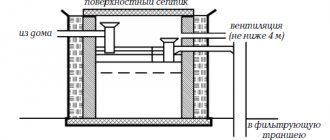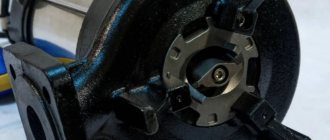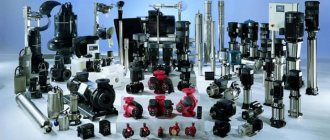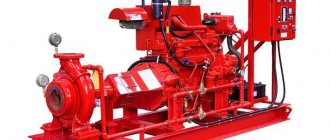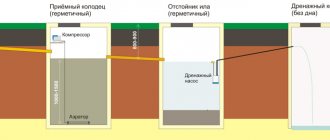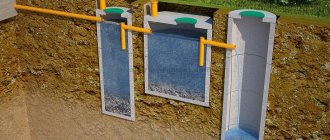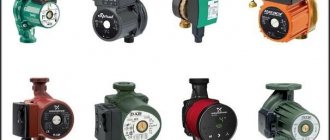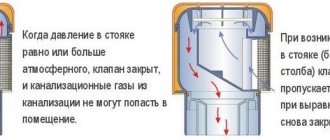When building a country house, it is necessary to create a sewer system. This is necessary to discharge wastewater to a filtration field or to a septic tank. There are various designs in which wastewater moves both by gravity and by forced pumping of liquid. To do this, they use various fecal pumps for sewage – which one to choose is an important question.
Using fecal pumps to pump out sewerage
To pump out wastewater, two types of pumps are used - drainage and fecal. The difference between them is small, but important.
The former are used for pumping dirty liquids containing solid objects no larger than 5 centimeters in size. To protect the working part of the mechanism, a metal mesh is attached to the pump inlet.
Fecal water is noticeably different; it is a thick liquid that often contains fibrous clumps of wool, hair or fabric. They will quickly clog the screen and the pump will stop working. For this reason, a grinder is installed on sewage sewage pumps.
Criterias of choice
You can answer the question of how to choose a fecal pump by studying the following characteristics of the equipment:
- Power, performance. That is, the speed at which it can pump out wastewater.
- The body and main components must be made of durable materials, not susceptible to corrosion, and not react with chemicals.
- Protection. It is important that the motor is protected from overheating, and in submersible types, all structural elements are protected from waste.
- Availability of service in your or the nearest (accessible) locality.
It is also worth paying attention to reviews; they sometimes say much more than technical specifications.
As you can see, there are many options for which pump to pump out a cesspool or septic tank; you should choose based on the type of wastewater, installation conditions and financial resources. The frequency of use and transportability of the installation are also important.
Design and principle of operation of a fecal pump
The main advantage of this small mechanism is the ability to move dense waste through a sewer pipe to a height of up to 7 m and a distance of up to 100 m.
Pump device
These are small but complex devices, the design of which includes:
- Frame. It is made of stainless steel, cast iron or plastic. Considering the operation of the mechanism in an aggressive environment, it is desirable to have a stainless steel case;
- Rotor and stator. Pump motor design elements;
- Shaft. Transmits rotation to the working body;
- Seals. Protects the inside of the mechanism from the ingress of aggressive substances;
- Working turbine. Pumps wastewater from the suction to the supply opening.
The mechanism is equipped with brackets necessary for attaching hoses and cables.
Materials
It is important to understand that the pump for pumping out fecal matter faces an aggressive environment. Therefore, the housing elements and its parts must be reliable. Depending on the manufacturer, the sewer apparatus is made of the following materials:
- Stainless steel.
- Plastic.
- Cast iron.
Plastic is used on budget installations. A drainage pump for sewerage made of plastic is relatively fragile and does not have high power. The most expensive device is made of stainless steel. But the high price is fully compensated by the quality and long service life. Cast iron is in the middle price category.
Of the listed materials, the best is stainless steel.
Operating principle and technical characteristics of the pump mechanism
Although this is a complex device, it works simply. When the turbine rotates, it carries wastewater under pressure into the sewer pipe, while simultaneously grinding solid inclusions.
Pumping wastewater under pressure is only necessary if plumbing fixtures are located below ground level (in basements or semi-basements). In this case, wastewater cannot flow from the collector into the septic tank by gravity; it must be pumped forcibly.
The daily volume of fecal water and the technical characteristics of the pump are important here:
- Productivity - the amount of waste that the mechanism is capable of pumping in 1 hour (for example, 100-200 l/hour);
- Power consumption - for use in a country house, a low-power pump is enough - no more than 400 W/hour;
- The height of the column (the pump is not at all below the soil level) or the immersion depth of the mechanism - for fecal pumps 15 m maximum;
- Mains voltage – in a private house, it is better to install pumps with an operating voltage of 220 V.
The characteristics of the equipment used for pumping fecal water are varied, but in each case it is possible to select the optimal parameters of the device.
What parameters should I pay attention to?
When choosing fecal drainage pumps, attention should be paid to the following characteristics:
- Maximum size of fractions (particles). The higher the indicator, the better. If the specified size is more than 50 - 60 millimeters, then such a pump is universal; there is no need to install a separate chopper under it.
- Power. It is expressed in the number of engine revolutions per minute, as well as the electricity it consumes. In domestic sewer systems, the best option for a home is up to 1 kW (in most cases, 0.3 - 0.5 kW is enough). But among submersible pumps, the minimum recommended power is 1.2 kW (such a pump will cope well with vertical pumping of wastewater to a height of up to 15 meters).
- Diameter of inlet and outlet holes. They should be chosen the same as those of the installed sewer (so as not to install a lot of additional adapters and fittings).
- Maximum diving depth. This parameter indicates to what height the pump can lift viscous liquids from the pit. The higher the better. Pumps where this parameter is less than 5 meters are not recommended to be used. And you should focus on the depth of the operated septic tank.
- Temperature range within which operation is allowed. Most modern pumps can be used at ambient temperatures down to -20 degrees, but the temperature of the pumped liquids should not fall below +5 degrees. In cheap models, the lower limit is set at +10 degrees.
- The presence or absence of a float switch (used only in submersible sewage pumps). With its help, the pump automatically turns off when the level of wastewater in the sewer pit drops to 10 - 40 cm. If there is no such switch, you will have to independently ensure that the pump does not begin to suck in dense large fractions from the day of the sewer pit (from which it may become clogged - such waste must be removed at least once every 2 years using a sewer machine).
Sewage pumps types/types/varieties
Although there are many different models of such pumps, they are all divided into several types:
Submersible mechanisms are made of durable materials; they always have a float mechanism for turning the device on/off. The pump has a sealed housing; all connections are equipped with gaskets that protect the inside of the device from exposure to aggressive environments. They are mainly used for emptying cesspools, but they are also suitable for pumping out storm drains. They are capable of solving many problems; a submersible fecal pump can even be used to drain a vegetable garden. They are installed at the bottom of the tank, secured to the suction pipe. The float switch is able to turn off the device in time, preventing it from being turned on after the container is empty (because of this, the pump may burn out). The pumped fecal water serves to cool the mechanism. A submersible pump is a very reliable device;
Semi-submersible mechanisms have a smaller outlet pipe diameter. It is capable of pumping wastewater with solid inclusions of maximum 15 mm. But they must be equipped with a device for grinding solids, for this reason they can be used for pumping out wastewater. Semi-submersible mechanisms are mainly installed on a floating platform, which is always at the same level with the pumped liquid. When this device operates, the bottom of the pump is always immersed in liquid, and the top part is in the air;
Surface pumps are placed outside the tank with fecal waste, for this reason they require a protective casing. These mechanisms are low-performance; they can pump wastewater with solid inclusions up to 5 mm in diameter. But the long service life and low cost of the device make it attractive to owners of private houses;
Domestic sewer stations are used for pumping waste fecal water; they allow solving several problems:
- Possibility of pumping out fecal water, along with water coming from other plumbing fixtures installed below the level of the sewer line. Such pumps make it possible to raise wastewater to a height of up to 15 m, thanks to this it is possible to install household plumbing in the basement or basement;
- The use of these devices makes it possible to transport wastewater and fecal matter over a distance of up to 100 m, without thinking about providing the necessary slope. There is no problem with seasonal soil movements, which can deform a long sewer pipe;
- The use of a grinder for large inclusions allows you to obtain a homogeneous mass of fecal waste, which allows you to lay a sewer pipe with a diameter of 40-50 mm;
- These pumps allow you to install a carbon filter, which will prevent unpleasant odors from entering the room.
To select a suitable pump, take into account:
- At what depth is the sewer system laid and are there any differences in the height of the laid pipe;
- Type of wastewater – composition of inclusions and temperature;
- The amount of wastewater that needs to be pumped;
- The need for automatic operation and a suitable way to control the pump.
Household sewage pumping units are small in size and do not require much space.
Feces grinders
First of all, you need to find out what materials need to be crushed:
- From the kitchen sink, where, in addition to fats, food debris gets into the sewer system, leading to clogged pipes;
- The washing machine and sink produce animal hair, hair and fibrous materials when washing fabrics. Combining with fats, they form dense blockages;
- Tampons, all kinds of napkins and paper end up in the sewer system.
All this waste must be processed by a shredder. This device works like a simple meat grinder. The device itself acts as an auger that moves the crushed material. Taking into account the characteristics of the waste being processed, the grids and knives of the mechanism are made from high-strength stainless and alloy steels.
Knives of several shapes are used:
- impellers with blades-knives;
- knife-like meat grinders;
- cylindrical scissors;
- cross secateurs;
- knives in the form of plates.
It is important that no stones or similar objects get into the shredder, otherwise the mechanism may break.
Selecting a fecal pump
To pump out sewerage, you need to choose a device taking into account several characteristics:
- Supply voltage, which affects the energy costs required for pumping wastewater. Usually in your own home you use a voltage of 220 volts, but you can also buy pumps designed for 380 volts;
- Power consumption for such a device, this characteristic should not be less than 400 watts. This directly affects the pressure of the pumped waste, which is necessary to overcome the resistance of the pipeline contents;
- For submersible pumps, the possible immersion depth of the device must be taken into account. And for external ones - the permissible length of the intake sleeve;
- The performance of the mechanism is important - the volume that can be pumped in a certain time. It should not be less than the calculated indicators of incoming wastewater. In most cases, 400 watts of pump power is enough to pump out 80-100 liters of wastewater per minute;
- Be sure to equip the device for removing waste with automatic on/off devices. Protection against engine overheating, short circuit, and electrical breakdown is required. It is necessary to provide for the installation of check valves that make the reverse flow of wastewater impossible.
It is important to consider the reputation of the equipment manufacturer. Now on the market you can find many fakes that copy equipment from reputable and well-known manufacturers. For this reason, it is necessary to study the source of origin of the pump and all quality certificates for the product.
Recommendations for self-installation
Mobile fecal pumps are installed in a container with a working medium in accordance with the operating instructions, and it is useful to adhere to the following recommendations:
- The fecal pump for pumping out sewage must be installed so that the waste pumped out from the bottom does not clog its inlet pipe; if there is a large layer of dirt there, the unit is placed on a solid and level base.
- When installing a fecal tank, it is necessary to ensure the free movement of the float in the pit, choosing its location with the greatest distance from the walls of the tank.
- To transport liquid from submersible pumps, it is better to use a rigid polymer pipeline - its smooth walls have the lowest hydraulic resistance compared to other materials - this increases the productivity of the unit and prevents clogging of the passage channel with waste.
- To prevent wastewater from flowing back into the source when the electric pump is turned off, a check valve is installed in the system if it is not provided for in the design of the unit.
Rice. 15 Basic methods of installing a submersible sewer
Sewage pumps are widely used in households for organizing forced sewerage as part of compact home installations, and for external use when filling drainage wells and pumping waste from cesspools. Units are supplied to the pumping equipment market by European manufacturers from Italy, Germany, and Denmark; they compete with products of Russian brands manufactured at Chinese and domestic production facilities.
Rules for using equipment
Every technically complex mechanism can quickly break down if used incorrectly. For example, the operation of a submersible pump after pumping liquid from a container. This type of pump uses pumped wastewater for cooling. If the drains run out and the pump continues to work, the engine will quickly burn out from overheating.
The same thing will happen if you use the equipment for other purposes. For example, it is dangerous to pump out drainage water with it. The reason is that there are a lot of hard stones in the pumped liquid. In the shredder, these particles will damage the knives, and the pump will no longer be able to work normally.
Before putting the fecal pump into operation, you must familiarize yourself with the operating rules. Violation of them may result in early termination of the equipment warranty.
Hot waste pump with grinding function
This type of pump is great for kitchens because the cooking process causes food particles to get into the drains, which can clog the pipes. Such a pump is capable of thoroughly grinding any type of waste at temperatures up to 95 degrees Celsius. You can choose a similar pump at https://pump-tech.ru/katalog/fekalnye_nasosy/fekalnye_nasosy_s_izmelchitelem/.
The pump operates from a standard outlet and is equipped with special knives that do not require constant sharpening. Thanks to this, small objects will be ground into small pieces that fit perfectly through the pipes. The price of such a pump will vary in the price range from 600 to 1200 dollars.
Main manufacturers of fecal pumps
This equipment is produced by many manufacturers. Common in our market:
Pedrollo pumps. Mechanisms of this brand are used for pumping very dirty wastewater. The most common are the VXm MC/MCm lines. Of these, the first ones are not very powerful; their operation requires power from a 220 volt network, the rated power of the pumps is 0.6 kW. These are the most common devices for pumping out fecal water in private homes. According to the instructions, it is allowed to pump wastewater with a solid element size of up to 35 mm. Technical characteristics of the equipment:
- voltage 220-380 volts;
- maximum liquid level to the bottom of the container – 40 mm;
- device productivity 15-66 l/hour;
- Pumps of this brand can be immersed to a depth of 8-22 m;
- the diameter of the outlet pipe is 1.5-2.5 inches.
Fecal pump Grundfos SEG. The unit is equipped with a grinder and is designed for pumping sewage, drainage water, and wastewater. It is capable of pumping wastewater over considerable distances, but the pipe size is limited to 40 mm.
Main characteristics of the equipment:
- body material – cast iron;
- the pump is equipped with an impeller adjustment system;
- 2 relays are installed to protect the device from overheating;
- used for pumping to a depth of 10 meters;
- the maximum permissible temperature of the pumped liquid is 40 degrees.
Sewage pumps Gillex. The company produces two types of pumps – Fekalnik and Drainazhnik, the names of which indicate their purpose. The permissible size of solid inclusions is 35 mm.
Main technical characteristics:
- productivity 160-260 liters per hour;
- immersion depth – 6-11 m;
- installation of a float switch.
Sulzer – pumps for pressure sewerage. This is a station for pumping fecal wastewater with its simultaneous processing into a liquid mass. Their advantage is that they are quick to install and get up and running. The station is equipped with a reliable check valve and a powerful solids grinder.
The Vortex fecal pump is designed for pumping wastewater with strong fibrous contaminants. Used for domestic purposes. Main technical characteristics:
- power 450-1500 watts;
- pressure 9-18 meters;
- productivity 16-24 cubic meters per hour;
- solid inclusions of 15-42 millimeters are allowed;
- permissible liquid temperature is 40 degrees.
Using a pump for forced pumping of sewage is often a forced decision that is influenced by the surrounding landscape.
Fecal or drainage – let’s clarify ↑
Although a representative of this category of household equipment bears the loud name “fecal”, in fact this is a reflection of only one function of the device. It is more correct to call it “drainage”. In relation to pumps, these are synonyms.
Such devices are capable of pumping out not only clean water, but also a suspension rich in solid and fibrous fractions. The size of the permissible fraction depends on the type of equipment. Typically, the size of inclusions ranges from 1.5 mm to 50 mm. Larger particles can damage the structure.
Huge species diversity
Installation of a fecal pump
Installing a fecal pump is not a difficult, but responsible job; you can do it yourself. In difficult cases, if there is no necessary experience, it is better to invite specialists.
Pump installation
Before installing the equipment, it is necessary to prepare the installation site and connect the electrical panel. Sometimes it is necessary to additionally install a fecal pump in a separate room - in the kitchen or bathroom, and so on. The most important thing in this case is not to connect the devices to one electrical panel; for each of them you need to provide its own connection and its own input into the sewer system.
Important! Take the wastewater temperature into account. A dishwasher or washing machine in the kitchen requires the use of a pump that is designed to pump hot liquid.
When installing a fecal pump, you need to follow a few simple rules:
- connect the mechanism to a separate electrical panel;
- secure the mechanism well;
- an external fecal pump is mounted on the edge of a container with waste water;
- the submersible pump must be lowered directly to the bottom;
- semi-submersible pump - install so that the upper part is at the top and the working mechanism is lowered into the liquid.
Installing the device in a toilet is characterized by the use of a larger diameter sewer pipe, and it is necessary to install a pump with a grinder - it is necessary to grind toilet paper and feces. The mechanism should be located no further than 40 cm from the toilet.
After the pump is finally installed and connected to the electrical network, it is necessary to test the equipment and adjust the operation of the float switch according to the liquid level. Ev container is filled with water to the minimum level, this will be the shutdown point. After this, water is poured in until the pump switch is activated. If you notice noises or malfunctions in the operation of the equipment, it is advisable to eliminate them immediately. If there are no comments, you need to seal the well.
Principle of operation
A fecal pump with a grinder for a toilet works according to the following scheme:
- The liquid is sucked into the working chamber.
- The cutting mechanism is located at the inlet, that is, the waste enters the pipe already crushed to small particles.
- The flow picks up speed and, under pressure, enters the pipes through which it is discharged outside.
When purchasing a unit, you need to pay attention to the labeling. The presence of certain letters determines what kind of waste and what size the device can pass through:
- if the abbreviation contains only numbers, the equipment can pump and grind waste up to 5 mm in diameter;
- if the letter “f” is present, the device crushes and pumps long fractions - rags, garbage - with a diameter of up to 35 mm;
- if there is a letter “n”, the unit is capable of operating in aggressive liquids for a long time, all its parts are made of appropriate materials.
Similar structures are installed on cesspool trucks, which are called to empty autonomous septic tanks.
How to choose a fecal pump for sewage
If you need equipment for pumping out wastewater, it is important to pay attention to several characteristics of the device when purchasing.
The mechanism will work for a long time if you take into account:
- required performance;
- sewer pipe diameter;
- total amount of wastewater;
- pump immersion depth;
- pressure;
- type of mechanism;
- pump power;
- additional options – chopper, liquid volume control;
- the manufacturer of the product.
Maximum head
This characteristic indicates the pressure that the pump can create. This is the second most important indicator of the effectiveness of the mechanism. It is measured in meters, as this allows you to understand to what height the pump is capable of pumping liquid. It is necessary to choose a pump so that its pressure is sufficient to lift the liquid to the required height. Greater pressure can only be achieved by using expensive, high-performance devices.
Suction/immersion depth
It is necessary to take into account the characteristic of the device, which depends on the location of the personal plot - the immersion depth. This indicator is determined by the purpose of the mechanism, and affects the ability to pump wastewater; it happens within 3-20 m.
Power
When choosing a suitable pump for pumping sewage, consider its power. This directly affects the performance of the equipment, the ability to pump out viscous substances containing solid particles and the energy costs during operation. This characteristic affects the pressure; the power depends on the manufacturer and model.
Working temperature
Any fecal pumps intended for domestic sewage are divided into 2 types:
- For cold wastewater - the liquid temperature does not exceed 45 degrees;
- For hot wastewater – liquid temperature up to 90 degrees.
When only cooled liquid enters the sewer, it is better to use models designed for cold water, but it is not prohibited to install pumps for hot water (but they are more expensive). These pumps are used in private homes. Hot water enters the sewer system from the washing machine and dishwasher and during emergency discharges of coolant from the heating system.
Automatic control
To control the pump when pumping out wastewater manually, you will have to turn it on and off yourself all the time, and this is inconvenient. Will be required to be near equipment frequently. It is better to purchase devices that include:
- A float is an element that determines the height of wastewater in a tank; it allows you to turn the equipment on and off in a timely manner;
- Thermal relay is a device that is triggered when the electric motor is significantly heated, this allows you to turn off the power to the pump in a timely manner, preventing overheating.
To reduce the risk of clogging of the pump with a grinder, manufacturers sometimes install a self-cleaning device for the mechanism that crushes large particles. This makes it possible to increase the service life of equipment without stops and interruptions in operation. Cleaning the chopper yourself further reduces the risk of motor overheating.
The most efficient and most reliable fecal pumps are devices with a metal body and working part. For this purpose, stainless steel and cast iron are used. Plastic products cost less, but when working in an aggressive environment they will fail faster.
How to use it correctly
When using fecal mobile electric pumps, the following basic rules for their operation must be observed:
- The working medium pumped by fecal electric pumps is water with organic components and long-fiber inclusions; their use for transporting aggressive chemicals and flammable liquids (gasoline, oils) is prohibited.
- The unit should be selected with such power to avoid exceeding the maximum permissible number of cycles of its repeated switching on and off; to increase service life, it is advisable to reduce this figure as much as possible.
- When connecting a sewer pipe to an electric pump, the latter must have an internal diameter along its entire length equal to the size of the outlet pipe - this will prevent a decrease in productivity and clogging of the pipeline with fecal waste.
- When long-fiber waste is found in the sewer, be sure to install a grinding attachment or use a special impeller that destroys the fibers.
- In addition to the float switch, the units must be equipped with internal protection against dry running and winding overheating - this will prevent their failure if the float that turns off the power does not operate correctly.
- During operation, the oil level and its condition in the units are periodically checked - if it has acquired a milky white color, this indicates a violation of the tightness of the seals and water entering it.
Rice. 14 Forced sewerage with a pump - examples of placement in the house
Features of sololift installation
The sololift is a receiving tank, therefore, it should be the lowest point for the sewerage installation. The reservoir has a certain height, on which its useful capacity depends. Therefore, sewer pipes in the corresponding rooms have to be laid slightly higher than in standard ones, otherwise they can quickly become clogged due to incomplete drainage.
If the pipes are already laid at the usual level and their alteration is not advisable, then the installation of the sololift is carried out with recess into the floor, for which a pit is made.
Usually, a vertical part of the sewer pipe immediately comes out of the tank, which turns into a horizontal section under the ceiling. The latter, if possible, should be performed with a slope towards the point of entry of the pipe into the gravity collector. This will allow the wastewater to drain from the horizontal section, facilitate the operation of the pump and reduce the degree of clogging with fat deposits on the walls of the horizontal section of the collector.
In the section of the vertical collector, immediately after the check valve, a ball valve should be installed, the same cross-section as the collector, to minimize the drainage of wastewater when dismantling the sololift, repairing and servicing the check valve.
Review of popular manufacturers
Today there are many companies manufacturing pumping equipment. Of these, the following several lines are the most popular in the segment of products of this type:
- Gilex . A domestic manufacturer that uses long-proven technologies and new developments from the world's best companies. The equipment is capable of pumping out wastewater containing silt and sand inclusions, as well as large particles up to 35 mm in size. The advantage of the product is its low price.
- Grundfos . The Danish company produces reliable, powerful equipment for pumping cesspools, including those with stagnant deposits. Durability in operation is ensured by the ability to adjust power and thermal relay. The downside is the fairly high cost.
